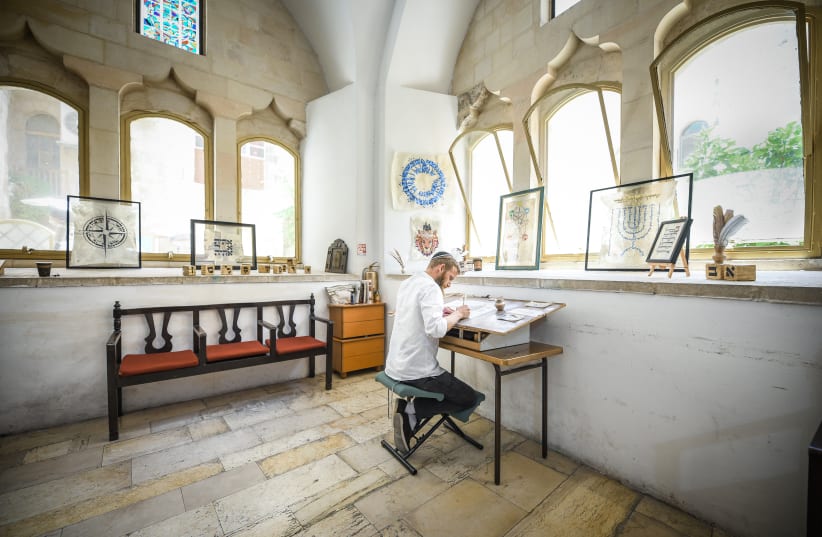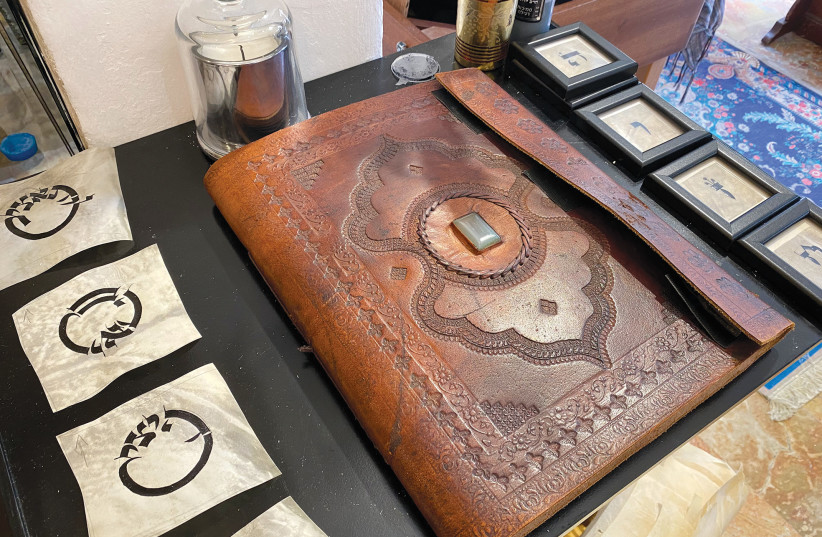“My vision is to be something that I don’t see in the Old City. You have the museums, you have the artifacts, you have the Kotel, you have the tefilla, you have Holy Bagel. There’s a huge gap,” says Kalman Gavriel, aka The Jerusalem Scribe. “My store is here to fill that gap, to help direct and inspire people.”
For the past eight years, he has been creating handmade works of Judaic calligraphy and running workshops for groups such as Talit-Birthright and even Christian tourists – everyone finds a bit of spiritual fascination in quilling the Hebrew letters of their name onto parchment.
“It’s an opportunity for self-expression and inspiration through this craft. I love teaching and talking about meaningful things,” Kalman says. “Writing the letters inspires me because it’s full of thought, kavanah [intention] and religious fire.”
His studio in the Four Synagogues Complex is lovely and large, but off the beaten path. So in February, he opened a boutique gallery at 58 Habad St., a high-traffic corner above the Cardo. He shares the space with a biblical costume shop called Live the Bible.
“We have a lot of common ground,” he points out. “I try to make the letters of the Bible come to life in my artwork.”
In addition to ready-made pieces, Kalman enjoys custom work “where someone gives me their favorite verse and chooses the parchment, design and color palette. I’m a very visual thinker,” he says. “Let’s say the verse is hinei matov u’mah naim, shevet achim gam yachad – ‘Behold how good and pleasant, brothers sitting together,’ from Psalm 133. I form a picture in my head of writing that verse in the shape of a table.”
These works range in price from NIS 600 to NIS 6,000. But there’s nothing snooty about The Jerusalem Scribe. Totally open to the street, the vibe is casual and inviting.
“My concept of the store is a high-end scribal arts gallery and a creative beit midrash,” Kalman explains.
The beit midrash (study hall) is centered on a bookshelf full of hassidic, mystical, musar (ethics) and philosophical works, much of it in English. Authors range from Aryeh Kaplan to Adin Steinsaltz. There’s even a book on mindfulness, Search Inside Yourself, by Google engineer Chade-Meng Tan.
“I can seat 30 people in here,” Kalman says. “My vision is to create a meeting place for small groups, families, people coming from abroad, artists from abroad, different rabbis, alternative types of people. A tour guide can use this space to talk for 15 minutes, and I’ll give them coffee and talk for two minutes. I want meaningful conversations and experiences to happen here,” he says.
KALMAN, 33, started out as a sofer STaM (a scribe who writes the parchments for Torah scrolls, tefillin and mezuzot) while studying in yeshiva after emigrating from Minneapolis.
“Afterward, while I was in the army, I realized that I could bring my own personality, my own inspiration from where I’m coming, and connect that with this beautiful trade of sofer STaM,” he says. “I feel like the middleman between your classic ultra-Orthodox sofer STaM and the mainstream.”
Kalman currently has an exhibition at the Stern Gallery on the Hebrew University of Jerusalem’s Mount Scopus campus. Sometimes the Hebrew letters themselves are the artwork and sometimes the letters form pictures. But he does not do micro-calligraphy; his letters stand out big and bold.
One of his ready-made works is a map of Israel composed of the words of the prayer for the State of Israel. Another is a classic shiviti (the verse from Psalm 16:8), a seven-branch menorah containing a meditative representation of the verse from Psalms, crowned by God’s name.
“The idea is that when we have Torah content, then we add to it from our own creativity to beautify it. It’s like an etrog on Sukkot. You can’t just take a beautiful mango; you need the real thing, and you make it more beautiful. You get a special box for it.
“Unfortunately, what I’ve seen in Judaica artwork is that a lot of people spend so much money on the box, and they forget to buy the etrog,” he says. “They’re missing the point. So this is my attempt to show my version of what Judaica artwork can be.”
Passersby seem drawn to drop by the shop and watch Kalman at work.
“I really believe part of this is the raised interest in spirituality. Here in the Old City, people are coming primed for a spiritual experience,” he says.
A family stopped in and noticed an outline of a hand that Kalman had sketched on his worktable. He asked them to suggest an appropriate biblical verse to inscribe on the hand. One of the kids said, “Etzbah Elokim hee, (This is the finger of God).” Kalman was delighted with the choice and wrote the words as they watched.
There was no attempt to sell them anything.
“I think it’s a natural issue artists have – what are we trying to do with our work? Are we trying to inspire? Are we trying to make a sale? There are two sides of it. The blessing for me is to be authentic and to be able to talk to people as they are,” says Kalman, who has a three-year-old daughter.
“One time I was talking to a little boy, and some rabbi walked in. And I didn’t stop talking to the kid to talk to the rabbi. I think he even got mad at me. But the lesson for me in that experience is that everyone is important. In 10 years, that kid will be like, ‘You remember when you wrote me one letter?’ It took me five seconds and he remembers it for 10 years. So that’s the idea. For someone to come here to be inspired from wherever they’re coming from.”
Kalman also gives private lessons on request. “I’m not a rabbi,” he emphasizes. “I do Judaic artwork that has a spiritual focus. All I know is how to write 22 little symbols and that’s my whole job.” ❖
The Jerusalem Scribe is open Sunday to Thursday from 10 a.m. to 5 p.m., Friday by appointment. thejerusalemscribe.com

